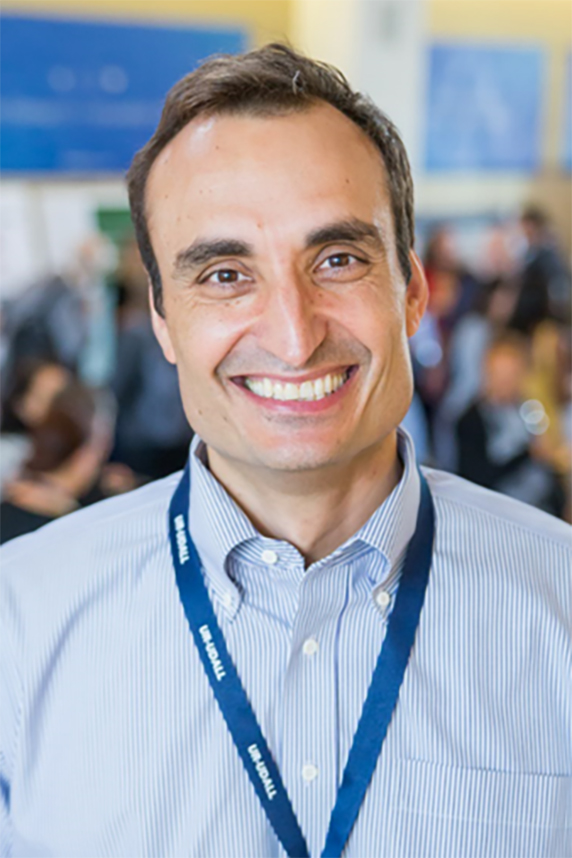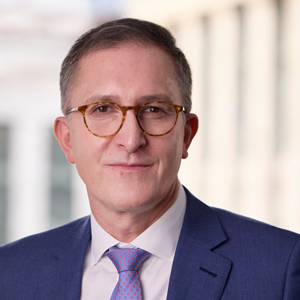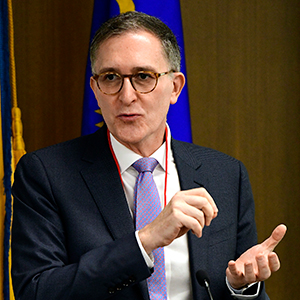 Rick Woychik, Ph.D., directs NIEHS and the National Toxicology Program. (Image courtesy of NIEHS)
Rick Woychik, Ph.D., directs NIEHS and the National Toxicology Program. (Image courtesy of NIEHS)At this year’s meeting of the American Neurological Association, held in late October, I helped to moderate a plenary session titled “Neurologic Dark Matter: Exploring the Exposome that Drives Neurological Disorders.” The exposome refers to all of the exposures experienced by an individual throughout life and their corresponding biological effects. Ray Dorsey, M.D., argued that when it comes to causes of Parkinson’s disease, scientists should focus on the role of multiple environmental toxicants, such as air pollution and pesticides, rather than genetics alone.
Dorsey is a neurology professor at the University of Rochester (UR) Medical Center, and he serves on the executive committee of the UR-Udall Center of Excellence for Parkinson’s Disease Research, among other efforts. The White House named him a “Champion for Change” for Parkinson’s disease in 2015, and in 2020, he co-authored a book titled Ending Parkinson’s Disease: A Prescription for Action. I recently spoke with Dorsey to learn about this disease, his thoughts on how to prevent it, and his career journey.
Rick Woychik: Can you provide Environmental Factor readers with historical perspective on Parkinson’s disease and why you believe that exposures are contributing to rising rates?
 “We can create a world for future generations where Parkinson’s disease is once again rare,” said Dorsey. (Photo courtesy of Ray Dorsey)
“We can create a world for future generations where Parkinson’s disease is once again rare,” said Dorsey. (Photo courtesy of Ray Dorsey)Ray Dorsey: Parkinson's is the world's fastest growing brain disease. When Dr. James Parkinson first described it in 1817, he identified six people with the condition. Today, the Global Burden of Disease Study estimates that more than 6 million people have the disorder worldwide. The last 25 years have seen great advances in our understanding of genetic causes of Parkinson's, but you don't go from six people to six million people with the disease because of genetic factors alone.
In the late 1990s, Dr. Caroline Tanner showed that rates of Parkinson’s were similar among monozygotic and dizygotic twins, suggesting that environmental factors are important. And if you look at diseases in general, Parkinson’s is among the least inheritable. Sir William Gowers wrote the bible of neurology in the late 1800s, and he remarked that only about 15% of patients had a family history of Parkinson's disease — a figure that is the same today.
So, what environmental factors are spurring the rise of Parkinson's? Numerous studies have linked air pollution to the condition. If you look at the brains of people with Parkinson's and especially Alzheimer's disease, you see large amounts of heavy metals. I think those metals might be getting there through our nose, through inhalation of that air pollution. Also, there is compelling evidence associating pesticides, many of which are neurotoxins, to Parkinson’s. And I believe that trichloroethylene [TCE], widely used in dry cleaning, is a major contributor.
RW: You co-authored a book titled Ending Parkinson’s Disease: A Prescription for Action. What was the impetus for writing the book, and did you learn anything surprising along the way?
RD: I had a gift of a sabbatical several years ago, and during that time, I ended up reading a lot of articles by Dr. Tanner detailing the risks of pesticides such as paraquat and rotenone, as well as TCE, with Parkinson's disease. I came to the realization that we may indeed know what causes the condition. I think the three biggest risk factors are pesticides in rural areas and, in urban areas, TCE and air pollution. Parkinson's disease is, to a large extent, man-made, and to the extent it is a man-made disease like lung cancer, it can be a human-ended one.
If we stop using pesticides that are 50 years old and known to produce Parkinson’s in laboratory animals; if we clean our air, which kills more people in one year than the COVID-19 pandemic has to date; and if we get rid of TCE, which causes cancer according to every health organization that I've seen and is associated with a 500% increased risk of Parkinson's disease, we could live in a much healthier world. That is a world where Parkinson’s disease isn't increasingly common as it is now but is rare like it was when Dr. Parkinson described it 200 years ago.
I don't think there's any reason we need to live in a world where 1.2 million Americans have Parkinson's disease, or a world where 100 people die every day because of it. The idea that this disease is preventable and that we can do something to end it is what gets me up every day.
RW: What research gaps would you like to see addressed in the coming years?
RD: There are many underexamined questions that involve air pollution. I think we should be doing long-term observational studies of individuals exposed to high levels of air pollution and individuals not exposed to high levels of air pollution and see what actually happens in terms of their health. With pesticides and TCE, there is a significant amount of evidence about health effects from exposure, so at this point, the issue is more about advocacy than research gaps.
That said, I think a big unmet need is developing biological markers that can show prior exposures. And I think that if we had better assays and better tools to do exposome research, that would allow us to get a lot more insights into what is likely causing the disease.
Also, I'm surprised that there aren’t more studies doing fat biopsies of individuals with Parkinson's disease because many pesticides are fat soluble and therefore brain soluble. So, trying to correlate levels of pesticides in people's fat with the disease deserves more attention.
RW: Any final thoughts for Environmental Factor readers?
RD: We live in the world where polio is extremely rare, where HIV is preventable and treatable, and so forth. Those are gifts that we’ve received in our lifetimes, and I think we have a duty to reciprocate. So, the challenge for us is about what we are going to give to future generations. I believe we can give them a world where Parkinson’s disease is once again rare.
(Rick Woychik, Ph.D., directs NIEHS and the National Toxicology Program.)









